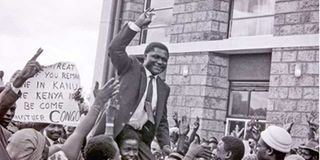
Tom Mboya at a political rally. The then Minister for Economic Planning and Development was shot dead on July 5 along Government Road (now Moi Avenue) in Nairobi City Centre.
On Saturday July 5, 1969, around 1:30 pm, I was walking along Government Road (now Moi Avenue) with Elizabeth Akinyi, a colleague at the Voice of Kenya (VoK) – now Kenya Broadcasting Corporation – towards the National Archives to take a matatu to Eastlands where we lived. We were neighbours. We had just left the station after finishing our duty.
We were chatting and cracking jokes after a busy morning schedule. We then heard commotion ahead. People were shouting “mtu ameuawa! mtu ameuawa!” (Someone has been killed! Someone has been killed!). We arrived at the scene immediately and saw a body lying next to a Mercedes Benz car. It was a man in jeans trousers and a T-shirt
“That is Tom Mboya’s car!” I shouted to Akinyi. I said it so loudly that the public turned and looked at me.
Police arrived very fast at the scene. People were beginning to mill around in large numbers.
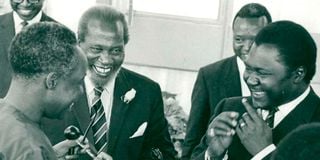
President Jomo Kenyatta, Tanzania President Julius Nyerere and Tom Mboya engage in a light banter at the Nairobi Airport on March 30, 1968. Tom Mboya was assassinated on July 5, 1969.
Also Read: The enduring mystery of Tom Mboya killer
I looked at the body keenly and told the people in the crowd, “huyu ni Waziri Tom Mboya ameuawa” (This is Cabinet Minister Tom Mboya who has been killed!)
Mboya was without his state-assigned security when a gunman shot him dead. He had driven himself to buy medicine at a chemist near the National Archives after returning from an official trip in Ethiopia.
Later, we learnt that he was on his way to City Stadium to watch a football match between his favourite team, Gor Mahia, and AFC Leopards.
Owing to his casual dressing, many people did not quickly recognise that the man lying dead was a senior government official.
Even before our own VoK could announce the incident, the BBC had already broadcast it in London as breaking news. The BBC announced: “Kenyan Minister Tom Ma-boya has been assassinated in the streets of Nairobi.”
The announcer with a pure English accent stressed the letter “M” in Mboya’s name so much that it came out as “Ma-boya.”
The events of that day affected Akinyi because she had earlier lost her friend, Polycarp Akoko Mboya, the father of her son, Charles Ochieng, who was murdered in November 1962 aged 31. She is the grandmother of Linda Adhiambo, whose son Divock Origi is a famous footballer plying his trade in Europe.
The killing of Mboya sparked riots across the country, more so in Nyanza.
It was an open secret that this was a political assassination. Mboya was eulogised back home as a brilliant leader who died in the hands of despicable masterminds of evil.
I knew Mboya as a well-learned and civilised man. He spoke fluent English. He was educated in St Mary’s Yala, Mang’u, and later Ruskin College (Oxford) in Britain.
In 1957, at the age of 27, he was elected a Legislative Council (Legco) member for Nairobi. Mboya was among the first African representatives who went to Parliament through competitive elections.
Other elected Legco members were Jaramogi Oginga Odinga (Central Nyanza), Masinde Muliro (North Nyanza), Lawrence Oguda (South Nyanza), Daniel arap Moi (Rift Valley), Ronald Gideon Ngala (Coast), Bernard Mati (Central Kenya), and James Muimi (Eastern).
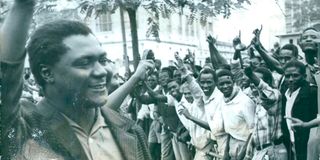
Tom Mboya is greeted by jubilant crowds flashing the Kanu one finger salut after the elections in 1963. Mboya was described in the Western world as personable and articulate. He even appeared on the ‘Time’ magazine cover in 1960.
In 1963, when Kenya attained Independence, Mboya was appointed Minister for Justice and Constitutional Affairs.
As a minister and ruling Kanu Secretary-General, the hardworking Mboya spearheaded the writing of Kenya’s numerous policy papers.
I covered his press conferences and was amazed at how he articulated issues.
His intelligence, charm, leadership, and oratory skills won him admiration from all over the world. This made Mboya a darling of the West, to the chagrin of Jomo Kenyatta’s men.
Political pundits monitoring Kenyatta’s succession politics often looked at Mboya as someone who was strategically positioning himself to take over Kenya’s top leadership, which earned him enemies.
This is the reason many people believed his assassination was “sponsored from the top”.
Mboya, born of peasant parents who worked on a white man’s farm in Kilimambogo, Thika, had a lot of friends in America and Europe.
On several occasions, he had addressed meetings in America when African Americans – led by Martin Luther King – were agitating for civil rights.
Mboya used his friendship with Americans to secure scholarships for young promising East African students in a programme that was famously known as “The Kennedy Airlifts”.
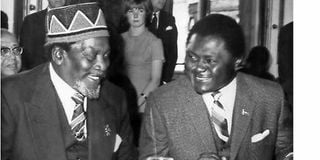
Mzee Jomo Kenyatta and Tom Mboya share a joke at the 1962 independence conference in London.
**
One of Mboya’s notable friends was called William Scheinman, who was a renowned businessman and a good friend of President (Lyndon) Johnson Baines of the US. Scheinman was close to Mboya and was very disappointed and deeply troubled when the latter was assassinated in Nairobi in 1969.
He came to Kenya and attended Mboya’s funeral in Lwanda Kamsengere village on Rusinga island, Homa Bay County. In his will, Scheinman wrote that he be buried next to Mboya upon his death. The wish was honoured when Scheinman died in 1999, aged 72. He was cremated in the US but his ashes were brought to Kenya and buried next to Mboya. That was how close the two men were.
**
Mboya’s death, coupled with the alienation of Jaramogi Oginga Odinga from the government, generated fury in Nyanza against Jomo Kenyatta and his government.
Despite knowing that the ground was not friendly in Nyanza, Kenyatta, the man who believed in taking the bull by the horns, decided to visit Kisumu in 1969 to open the Nyanza Provincial General Hospital, famously known as “Russia” because it was built through the support of Russians.
The visit came barely three months after the murder of Mboya.
I attended this Kisumu meeting as a reporter on duty for the VoK. We arrived in Kisumu the day before the event to set the machines for live coverage.
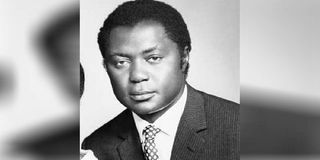
Tom Mboya.
“People are going to boo the president today,” one man said as we took breakfast. He added that there was tension in town.
The President arrived and we reported everything as it happened live. We received reports that the president Kenyatta had been heckled en route to Kisumu from Kakamega where he had spent the night.
As the speeches continued, with Kenyatta having already taken his place at the podium, there was much noise and shouts from the crowd: “Jaramogi!… KPU! KPU! Ndume!… Ndume!… We want Tom Mboya!… Tom Mboya!…”
When Kenyatta rose to speak, the noise increased tenfold. Our live broadcast was greatly interfered with so much that we could not get the feed from the Presidential dais. An agitated Kenyatta then turned to Jaramogi and told him angrily, “Tell your people to keep quiet… or I crush them...”
He then hurled abusive words at Jaramogi and questioned the usefulness of KPU to the Luo people. The two leaders exchanged nasty words angrily in front of the public. At some point, Kenyatta told Jaramogi, “Jaramogi if you were not my friend, I would have pounded you like maize flour!”
And in his characteristic style, the President threw another vulgar insult at Jaramogi.
This irritated the crowd started throwing stones, rotten eggs, among other things, at the Presidential dais.
Security agents jumped on the dais and surrounded the president.
However, the crowd kept surging forward. Our transmission wires were cut and we had to stop the live broadcast.
In a matter of seconds, there was shooting and pandemonium broke out. The function ended prematurely. Kenyatta was quickly whisked away to safety.
We packed our live broadcast equipment and fled from the violent scene.
Angry residents barricaded roads and threw stones at every passing vehicle.
Our VoK van was pelted with stones. Luckily, we were not injured.
The ceremony ended in a bloodbath with the presidential guard and the police shooting about 50 people dead.
Jaramogi was later arrested and detained for more than a year. His Kenya People’s Union (KPU) party was immediately banned. Kenyatta never visited Kisumu until he died on August 22, 1978.
- Part two (Friday December 22): Secrets of the 1982 attempted coup
©Leonard Mambo Mbotela






